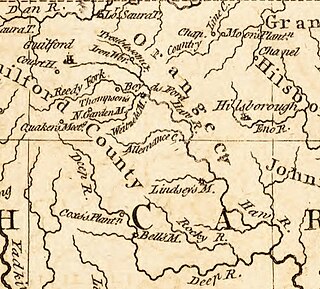
Orange County is a county located in the Piedmont region of the U.S. state of North Carolina. As of the 2020 census, the population was 148,696. Its county seat is Hillsborough.
Francis Nash was a brigadier general in the Continental Army during the American Revolutionary War. Prior to the war, he was a lawyer, public official, and politician in Hillsborough, North Carolina, and was heavily involved in opposing the Regulator movement, an uprising of settlers in the North Carolina piedmont between 1765 and 1771. Nash was also involved in North Carolina politics, representing Hillsborough on several occasions in the colonial North Carolina General Assembly.
Walter Gwynn was an American civil engineer and soldier who became a Virginia Provisional Army general and North Carolina militia brigadier general in the early days of the American Civil War in 1861 and subsequently a Confederate States Army colonel. He was a railroad engineer and railroad president before the Civil War, Florida Comptroller in 1863 and a civil engineer after the Civil War.

Susie Marshall Sharp was an American jurist who served as the first female chief justice of the North Carolina Supreme Court. She was not the first woman to head the highest court in a U.S. state, but is believed to be the first woman elected to such a post in a state, like North Carolina, in which the position is elected by the people separately from that of Associate Justice. In 1965, Lorna E. Lockwood became the first female chief justice of a state supreme court, but in Arizona, the Supreme Court justices elect their chief justice.
Browns Summit is a small unincorporated community in Guilford County, North Carolina, United States.

Robert Digges Wimberly Connor was an American historian who served as the first state archivist of North Carolina from 1907 to 1921, and later as the first Archivist of the United States from 1934 to 1941.

The Battle of Lindley's Mill took place in Orange County, North Carolina, on September 13, 1781, during the American Revolutionary War. The battle took its name from a mill that sat at the site of the battle on Cane Creek, which sat along a road connecting what was then the temporary state capital, Hillsborough, with Wilmington, North Carolina.
Shoals is an unincorporated community in the Shoals Township of Surry County, North Carolina, United States.

The Great Balsam Mountains, or Balsam Mountains, are in the mountain region of western North Carolina, United States. The Great Balsams are a subrange of the Blue Ridge Mountains, which in turn are a part of the Appalachian Mountains. The most famous peak in the Great Balsam range is Cold Mountain, which is the centerpiece of author Charles Frazier's bestselling novel Cold Mountain.
James Moore was a Continental Army general during the American Revolutionary War. Moore was born into a prominent political family in the colonial Province of North Carolina, he was one of only five generals from North Carolina to serve in the Continental Army. He spent much of his childhood and youth on his family's estates in the lower Cape Fear River area, but soon became active in the colonial military structure in North Carolina.
The Sam Ragan Awards are an annual fine arts award presented by St. Andrews University in Laurinburg, North Carolina. The award honors Sam Ragan who was a North Carolina Poet Laureate and North Carolina's first Secretary of Cultural Resources. It is presented annually for "outstanding contributions to the Fine Arts of North Carolina over an extended period--including, but above and beyond--the recipient's own primary commitment."

Samuel Finley Patterson was a North Carolina politician, planter, businessman, and member of the prominent Patterson family.

General Hugh Waddell was an Irish-born American military officer in the Province of North Carolina prior to the American Revolutionary War. Waddell formed and led a provincial militia unit in Rowan County, North Carolina and the Ohio River Valley during the French and Indian War and the Anglo-Cherokee War, and supervised the construction of Fort Dobbs near the settlement of the Fourth Creek Congregation. His career was well-served by close connections to several provincial governors of North Carolina.

Simmons Jones Baker was a physician, planter, legislator, and slave owner in North Carolina.

Annie Lowrie Alexander was an American physician and educator. She was the first licensed female physician in the Southern United States.

Julius Isaac Foust (1865–1946) was the second president of the school now known as The University of North Carolina at Greensboro, serving from 1906 until his retirement in 1934.

Rufus Lenoir Patterson was an American businessman and politician from North Carolina. Born into a prominent family, Patterson received private schooling before matriculating at the University of North Carolina. Electing to forgo a career in law, Patterson studied in a banking house and founded a series of mills in Salem, North Carolina. He served on the county court and was elected to a term as Mayor of Salem. Patterson was twice a delegate to state constitutional conventions. He was the father of Rufus Lenoir Patterson Jr.

Harriet Morehead Berry was an American civic leader, suffragist, and editor, active in the Good Roads Movement in North Carolina.
Walter Clinton Jackson was an American educator. Jackson taught history at the University of North Carolina at Greensboro from 1909 to 1932, and at the University of North Carolina at Chapel Hill from 1932 to 1934. He was head of the Woman's College of the University of North Carolina from 1934 to 1950. Jackson was also a member of several groups, including the Commission on Interracial Cooperation. He published several books and was the editor of An Anthology of Verse by American Negroes (1924) with Newman Ivey White.












